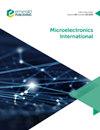A DFT+U study of structural, electronic and optical properties of Ag- and Cu-doped ZnO
IF 0.8
4区 工程技术
Q4 ENGINEERING, ELECTRICAL & ELECTRONIC
引用次数: 0
Abstract
Purpose The purpose of this paper is to investigate the structural, electronic and optical properties of pure zinc oxide (ZnO) and transition metal (Tm)-doped ZnO using Tm elements from silver (Ag) and copper (Cu) by a first-principles study based on density functional theory (DFT) as implemented in the pseudo-potential plane wave in CASTEP computer code. Design/methodology/approach The calculations based on the generalized gradient approximation for Perdew-Burke-Ernzerhof for solids with Hubbard U (GGA-PBEsol+U) were performed by applying Hubbard corrections Ud = 5 eV for Zn 3d state, Up = 9 eV for O 2p state, Ud = 6 eV for Ag 4d state and Ud = 9.5 eV for Cu 3d state. The crystal structure used in this calculation was hexagonal wurtzite ZnO with a space group of P63mc and supercell 2 × 2 × 2. Findings The total energy was calculated to determine the best position for Ag and Cu dopants. The band structures and density of states show that Tm-doped ZnO has a lower bandgaps value than pure ZnO because of impurity energy levels from Ag 4d and Cu 3d states. In addition, Ag-doped ZnO exhibits a remarkable enhancement in visible light absorption over pure ZnO and Cu-doped ZnO because of its lower energy region and extended wavelength spectrum. Originality/value The results of this paper are important for the basic understanding of the 3d and 4d Tm doping effect ZnO and have a wide range of applications in designing high-efficiency energy harvesting solar cells.Ag和Cu掺杂ZnO结构、电子和光学性能的DFT+U研究
目的利用密度泛函理论(DFT)的第一性原理研究纯氧化锌(ZnO)和过渡金属(Tm)掺杂的ZnO的结构、电子和光学性能。设计/方法/方法基于Perdew-Burke-Ernzerhof的广义梯度近似,通过应用Hubbard修正Ud=5对Hubbard U固体(GGA-PBEsol+U)进行计算 Zn3d态为eV,O2p态为Up=9eV,Ud=6 Ag 4d态的eV和Ud=9.5 对于Cu3d态为eV。计算中使用的晶体结构为六方纤锌矿ZnO,空间群为P63mc,超晶胞为2×2×2。结果计算了总能量以确定Ag和Cu掺杂剂的最佳位置。能带结构和态密度表明,由于Ag 4d和Cu 3d态的杂质能级,Tm掺杂的ZnO具有比纯ZnO更低的带隙值。此外,与纯ZnO和Cu掺杂的ZnO相比,Ag掺杂的ZnO表现出显著的可见光吸收增强,因为其具有较低的能量区域和扩展的波长光谱。原创性/价值本文的结果对于基本理解3d和4d Tm掺杂效应ZnO具有重要意义,并在设计高效集能太阳能电池方面具有广泛的应用。
本文章由计算机程序翻译,如有差异,请以英文原文为准。
求助全文
约1分钟内获得全文
求助全文
来源期刊

Microelectronics International
工程技术-材料科学:综合
CiteScore
1.90
自引率
9.10%
发文量
28
审稿时长
>12 weeks
期刊介绍:
Microelectronics International provides an authoritative, international and independent forum for the critical evaluation and dissemination of research and development, applications, processes and current practices relating to advanced packaging, micro-circuit engineering, interconnection, semiconductor technology and systems engineering. It represents a current, comprehensive and practical information tool. The Editor, Dr John Atkinson, welcomes contributions to the journal including technical papers, research papers, case studies and review papers for publication. Please view the Author Guidelines for further details.
Microelectronics International comprises a multi-disciplinary study of the key technologies and related issues associated with the design, manufacture, assembly and various applications of miniaturized electronic devices and advanced packages. Among the broad range of topics covered are:
• Advanced packaging
• Ceramics
• Chip attachment
• Chip on board (COB)
• Chip scale packaging
• Flexible substrates
• MEMS
• Micro-circuit technology
• Microelectronic materials
• Multichip modules (MCMs)
• Organic/polymer electronics
• Printed electronics
• Semiconductor technology
• Solid state sensors
• Thermal management
• Thick/thin film technology
• Wafer scale processing.
 求助内容:
求助内容: 应助结果提醒方式:
应助结果提醒方式:


